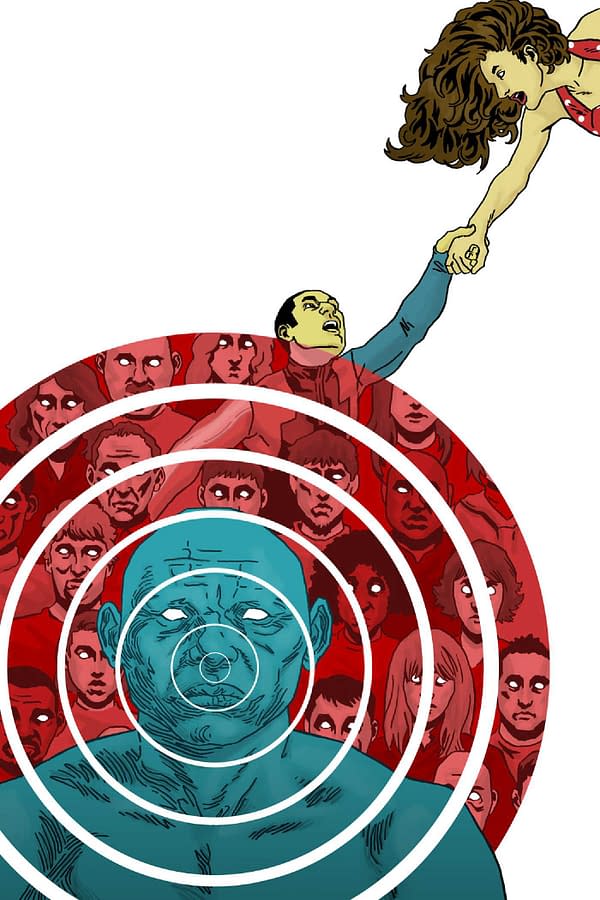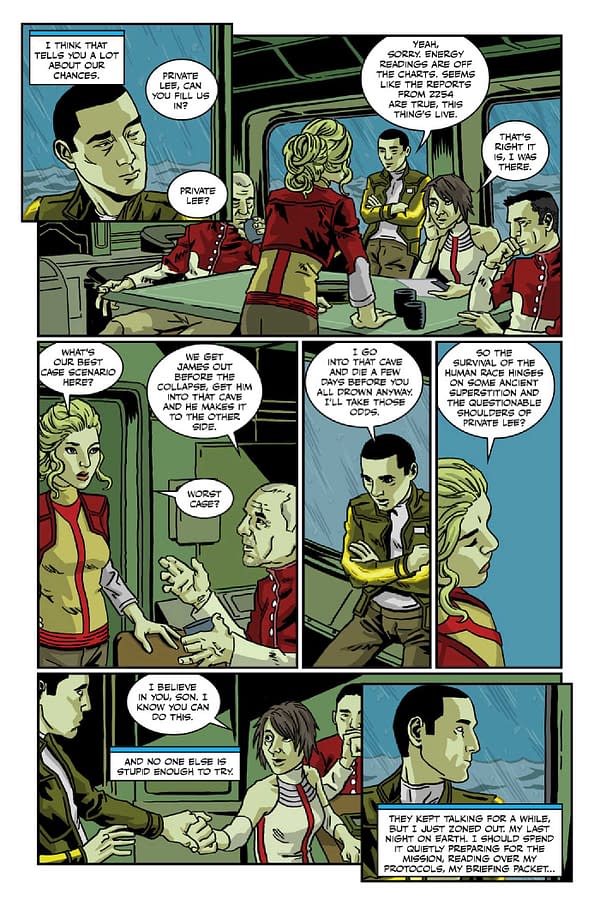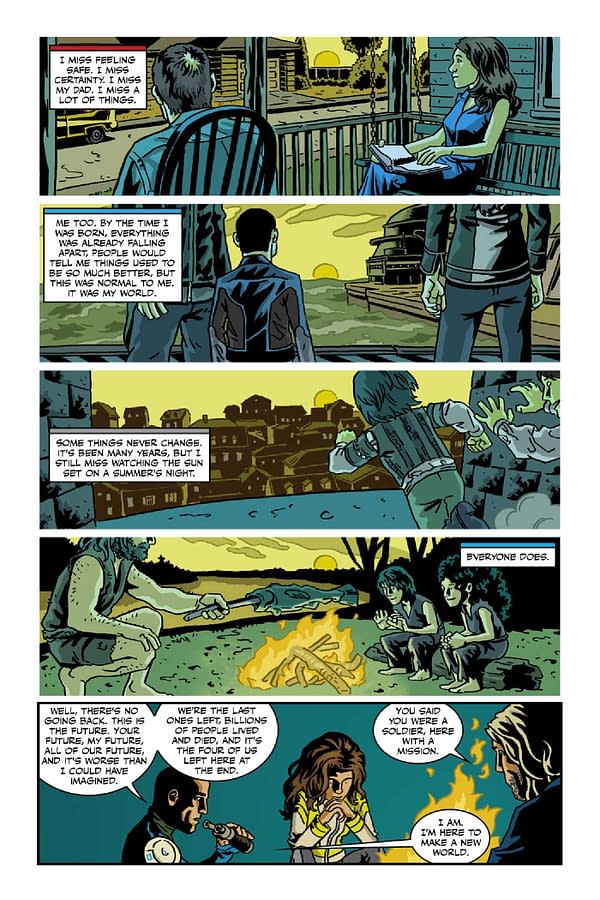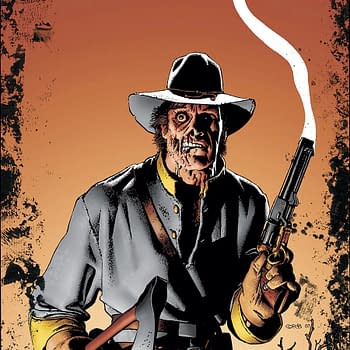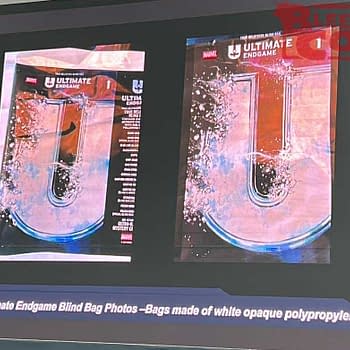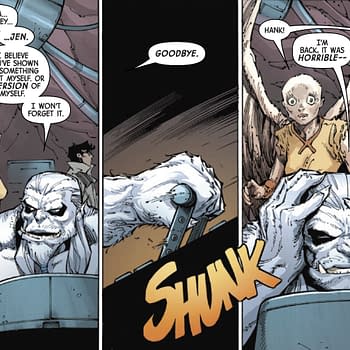Posted in: Comics, Recent Updates | Tagged: black mask studios, Comics, entertainment, Eric Zawadzki, grant morrison, Last Born, Patrick Meaney, Respect Films, the image revolution
Introducing Survivors On A Dead World In Last Born From Black Mask – Talking With Patrick Meaney And Eric Zawadski
By Tony Wolf
Writer / filmmaker Patrick Meaney is responsible (along with his producing partner Jordan Rennert of Respect Films ) for several well-known documentaries about several iconic comic book writers: Grant Morrison, Warren Ellis, and Chris Claremont (as well as an upcoming documentary about Neil Gaiman). Meaney makes his debut as a series writer with Last Born, drawn by Eric Zawadzki, a miniseries from Black Mask Studios that may defy simple description. We spoke to the writer and artist about their upcoming comic.
Tony Wolf: In your new 4-issue miniseries Last Born, we have time travel, character drama, trippy psychedelic sci-fi, and environmental themes. It feels like the thematic cousin (or grandchild) of Logan's Run, Zardoz, Grant Morrison's The Invisibles and Jack Kirby's Kamandi series. What inspired your idea for the series? And what significance does the title have in the larger context of the story you have planned?
Patrick Meaney: I pretty much thought about what kind of story would I want to read the most and tried to write that. So I took the really big apocalyptic universal themes you mentioned as a starting point, then tried to find an emotionally accessible way to ground the story in something real, and hopefully hit the right balance. I was definitely inspired by Morrison, Kirby and a lot of other comics people, but hopefully found a way to do it that feels fresh.
As for the title, the full significance will become apparent down the line, but for now it's mainly in reference to the fact that the characters are the last survivors on a dead world.
TW: You've done so many documentaries about comic book creators. At what point did you say to yourself 'Ok, I'm ready to make my own comic' and what was that process like?
PM: I've always wanted to write comics, and up until recently never imagined making documentaries at all. It was mainly getting the chance to tell these really cool stories that made me jump into the doc world, but I'd always had pitches and ideas developing for my own comic projects along the way. But, it wasn't until I got the chance to do a short for the Occupy Comics anthology that I was in a position to turn those pitches into reality. After Eric and I worked on that, we put the pitch pages together for Last Born and were off and running. But, I've always loved comics and like a lot of readers, always had ideas for my own books and stories to tell.
TW: Eric, how much did you and Patrick collaborate on the story itself, the pacing and such? Did you work "Marvel style" for this project?
Eric Zawadzki: It was written full script. When I'm collaborating on a project, I like to do detailed fully-lettered layouts, and send them to the writer so we can have a dialogue about what's working and what isn't. With Patrick, I think we sometimes treat it like an editing room where we discuss adding a page to play with the pacing or playing around with various scenes. I work completely digitally, so it's easy for me to play around. Patrick is a director, so he's very focused on visual elements when he's writing. Because of this skill set of his I really value his opinion throughout the process.
One example of a page that transformed during a discussion was the big collage splash page towards the end of the issue. That was scripted as a regular 6 panel page. Patrick looked at it and felt that the scene needed to be a little more surreal and it needed to more visually convey the horror of the scene. So I ended up taking a couple of hours in Photoshop moving the figures around, adding and removing elements and playing around with it just trying to find what works. In the end, it's a favorite of all that pages that I've ever done.
TW: You two have worked together several times – in the short story for the Occupy Comics miniseries (also for Black Mask Studios), and Eric provided some wonderful art for The Image Revolution, the documentary Patrick did about the founding of Image Comics. How did you guys first get connected as collaborators?
PM: Apparently, Eric used to read my blog years back, but we got in touch after I went on Twitter in search of an artist for the Occupy piece. His work there was fantastic, and we started developing Last Born. Along the way, we needed an artist for the Image pages, and he was the obvious choice.
EZ: I was actually a follower of Patrick's blog from several years ago. He wrote essays on comics, TV shows and movies and I really enjoy his smart analysis of the entertainment that I followed. I really appreciated how he added to my enjoyment of these properties. So when he posted on Twitter that he was looking for an artist, I jumped at the chance.
TW: What was it like working on the Occupy Comics miniseries with the likes of Alan Moore and Molly Crabapple? Who organized that anthology?
PM: The anthology was organized by Black Mask publisher Matt Pizzolo. It's pretty wild to know that my stuff is in the same book with Alan Moore or David Lloyd, and I liked getting to talk about Occupy, hopefully with a unique spin on the topic. Reading the book a few years later, it's a great document of the hope and excitement of the Occupy movement, and also bittersweet looking at the great hope people had compared to the way things turned out.
TW: What makes Black Mask different from other indie comic book companies? Some of our audience might not be familiar with Black Mask and their mission as a comics company. Also, Patrick, tell us about your business history with the company.
EZ: At San Diego ComicCon this year I spent some time with one of the founders of Black Mask, Matt Pizzolo, along with some of the other Black Mask guys and I was really inspired by what's going on there. I think anyone who listens to Matt talk about his views on the industry and his goals for the company will be on board immediately. I'm especially happy with some of the indie and established creators that they have lined up over the next several months. From what little I've seen, Black Mask is surrounding themselves with all the right people.
PM: Black Mask was created by Matt Pizzolo, Steve Niles and Brett Gurewitz (who also created Epitaph Records). Matt distributed the Grant Morrison and Warren Ellis documentaries that I directed and that was a great experience, so when he told me he was starting Black Mask, I wanted to pitch there right away.
What I really like about Black Mask is that Matt is trying to expand the comics readership. He's trying to do innovative marketing and content ideas to get books out beyond the usual channels, which is great. Comics have a lot of room to grow and he's trying to make that happen, and get out to people who aren't used to going to a comic book store, but still love good stories.
TW: The Viral Man is a concept carried over from a short film you did with actress Brea Grant and your production partner Jordan Rennert, which you can watch here for free. What led to you using this idea again for the series?
PM: I actually developed the idea for the comic book series first. I thought it was interesting, and decided to explore it further in the script for the short film. I think the idea of a single organism expressed in multiple people is pretty fascinating, and wanted to develop it in a few different media.
TW: Eric, in another interview about the comic, you said a key visual inspiration for the Viral Man's design was a character from the HBO show John From Cincinatti. Tell us more about that, for our readers who aren't familiar with that famously-cancelled David Milch show.
EZ: My initial idea to make his skin gray was inspired by a really disturbing moment in John From Cincinatti where we're briefly shown the character of Mr. Rolands. It was during the infamous Sermon scene. That was only the inspiration, though. Gray works as a color for the Viral Man because of what he represents, which I see as the blandness of conformity.
I love pretty much anything David Milch does, but John From Cincinatti isn't a perfect show for me. Although I really enjoyed the show, I have some problems with it. But I think Patrick and my brother are two of the biggest fans of John From Cincinatti around. I've somehow surrounded myself with big fans of the show, so it can't help but influence my work.
PM: John from Cincinnati was a hugely underrated show, it's David Milch presenting his cosmology of the universe through the story of a family of surfers in Southern California. True Detective got a lot of attention for exploring the nature of time and the universe, but JFC was doing it years ago in what I felt like was a much more ambitious and emotionally relevant way. It's a strange show for sure, but a hugely enjoyable one.
TW: You have the first mini coming out and you've planned out two more miniseries. Is there a concrete ending for this saga in sight, or do you think you could continue it even beyond the 3rd mini? As a teaser, what might the titles (or subtitles) be for the planned 2nd and 3rd Last Born minis?
PM: There's a pretty concrete ending at the end of the story. I have a lot of ideas about the universe and a huge timeline of what happens for millions of years through the story, and it's all going to be contained in the story itself, and wrapped up in a hopefully satisfying way at the end of the third volume. We don't have titles yet, but I'll say that structurally the original Star Wars trilogy is a big inspiration for me. I want the first volume to stand alone to some extent, the second volume splits the characters and darkens the universe, and the third builds to a big confrontation.
TW: Eric, what got you into comics originally and what was your path to becoming an illustrator? What are your long-term goals in the comics industry?
EZ: I've loved drawing and comics since before I could read. As for the future, I wouldn't mind bouncing back and forth between creator owned and licensed work. I love creating these new worlds. And there's a huge list of writers that I want to collaborate with. At the moment, though, I've got several projects on the go. On top of Last Born with Patrick, I'm also working on Headspace for Monkeybrain comics with my super talented co-creator Ryan K. Lindsay. I'm also always scheming something with my longtime collaborator Danny Djeljosevic.
TW: Patrick, any dream titles you'd love to write someday? Marvel, DC, Image – anything, the sky's the limit as far as this question is concerned.
PM: The big two character I'd really want to tackle is Zatanna. I loved what Grant Morrison did with the character in Seven Soldiers and felt like there was so much more to do. I'd have loved to write for DC in the late 80s, when Alan Moore, Grant Morrison and Neil Gaiman were all writing amazing stories that built on each other and created a cool shared universe. At Marvel, I'm a huge X-Men fan, so it would be pretty cool to do something over there.
TW: Give us three words that epitomize Last Born. First Patrick, then Eric.
PM: Emotional. Epic. Mind-bending.
EZ: I'm no good at this. "Artsy, personal blockbuster"?
TW: Eric, talk about the color palette you selected for the series. It must be interesting doing both the art and the coloring (as well as the lettering). There's a growing trend now in comics where the illustrator will also (via the technology available through Photoshop etc.) do the coloring; witness Ronald Wimberly's work on his graphic novel Prince of Cats and She-Hulk, as well as Farel Dalrymple (The Wrenchies, Pop Gun War, Prophet) and many others…
EZ: It has become more and more common because of the prevalence of Cintiqs and Photoshop. It's pretty common among independent creators, but also surprisingly some artists at the big two are able to pull it off. I originally got into coloring and lettering my own work out of necessity. In independent comics it's hard to find quality colorist collaborators that are willing to work for next to nothing. But I really love that I can create a full comic from beginning to end all by myself. And I've been at it long enough that I've got a pretty good routine going on. It's very time intensive, though. I can see myself giving up the coloring and lettering in the future in order to speed up my productivity.
TW: Did you listen to music while creating Last Born, and if so, anything specific?
PM: I always listen to music when I'm writing. Some of my favorite stuff for this series was Smashing Pumpkins' Melon Collie or Adore, Daft Punk's Tron Soundtrack, M83's Hurry Up, We're Dreaming, Lana Del Rey, Chrysta Bell, Florence and the Machine, Nine Inch Nails, and My Morning Jacket, to name a few.
Last Born #1 hits comic book stores on October 1st, 2014 from Black Mask Studios.
Follow Patrick Meaney on Twitter at @patrickmeaney and Eric Zawadzki at @ericxyz .
Tony Wolf (@tonywolfness) is an actor, voice-over guy, sometime illustrator and rabid pop culture fan in New York City. He can be found lurking about at www.tonywolfactor.com and was the co-host ofwww.theactionroom.com.





